St. Paul's Church (Halifax)
St. Paul's Church is an evangelical Anglican church in downtown Halifax, Nova Scotia, within the Diocese of Nova Scotia and Prince Edward Island of the Anglican Church of Canada. It is located at the south end of the Grand Parade, an open square in downtown Halifax with Halifax City Hall at the northern end.
| St Paul's Church | |
|---|---|
| St Paul's in the Grand Parade | |
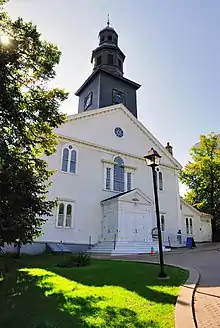 St Paul's Church | |

| |
| 44°38′51″N 63°34′29″W | |
| Location | 1749 Argyle Street Halifax, Nova Scotia B3J 3K4 |
| Country | Canada |
| Denomination | Anglican |
| Churchmanship | Low church |
| Website | Official site |
| History | |
| Founded | 13 June 1750 |
| Architecture | |
| Architect(s) | James Gibbs[1] |
| Architectural type | Georgian |
| Completed | 2 September 1750 |
| Official name | St. Paul’s Anglican Church National Historic Site of Canada |
| Designated | 1981 |
| Type | Provincially Registered Property |
| Designated | 7 November 1983 |
| Reference no. | 00PNS0006 |
The church is modelled after Marybone Chapel in Westminster, London, which was designed by controversial architect James Gibbs, the architect of St Martin-in-the-Fields at Trafalgar Square.
Built during Father Le Loutre's War, it is the oldest surviving Protestant church in Canada and the oldest building in Halifax.[2] There is also a crypt below the church. Close to the church is the St. Paul's Church Cemetery. The official chapel of the church was the Little Dutch (Deutsch) Church.
Saint Paul's was designated a National Historic Site of Canada in 1981.[3][4] In 1981, it was designated a Municipal Registered Heritage Property by the former City of Halifax, and in 1983 it was designated a Provincially Registered Heritage Property both under the provincial Heritage Property Act.[1]
History
Part of a series on the |
|---|
| History of Halifax, Nova Scotia |
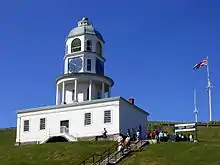 |
|
St. Paul's Church was founded in 1749 (the same year as the Halifax colony). The construction was begun in 1750 and is based on the ground plan of Gibbs' Marybone Chapel (later St. Peter's, Vere Street) in London, with later additions such as a larger tower. The Reverend William Tutty (1715–1754) opened the church on September 2, 1750.[5] Rev. William Tutty was the first minister (1750–54); followed by Rev. John Breynton (1754–91) and Rev. Thomas Wood (1752–64), who served at the same time.[6] The church also served as the site for the initial congregation of St. Matthew's United Church (Halifax) until this church was built.
During the French and Indian War (the North American theatre of the Seven Years' War), the church was the site of the burials of two prominent Nova Scotians: Governor Charles Lawrence (d.1760) and Catholic Priest Pierre Maillard (d.1762), the latter ceremony was attended by a large number of Mi'kmaq people. (Also during the war, the church was where Horatio Gates married Elizabeth Phillips in 1754.) Soon after the war, Vice-Admiral Philip Durell (d. 1766) was buried after having participated in the Siege of Louisbourg (1758) and the Siege of Quebec (1759).
During the American Revolution the church held funerals for Francis McLean (d. 1781) who defended New Ireland (Maine) during the war; Capt Henry Francis Evans (d.1781) who died in the Naval Battle off Cape Breton (1781); Baron Oberst Franz Carl Erdmann von Seitz Hatchment (d.1782) who was the commander of the Hessian soldiers that defended Lunenburg in the Raid on Lunenburg (1782); and Governor Michael Francklin (d. 1782), whose funeral was also attended by a large number of Mi'kmaq people.
After the American Revolution, with the creation of the Diocese of Nova Scotia in 1787, St. Paul's was given the Bishop's seat, making it the first Anglican cathedral outside of Great Britain. It served as the cathedral from 1787–1864.[7] The diocese included Nova Scotia, New Brunswick, Newfoundland, St. Johns (now Prince Edward Island), and across Quebec and Ontario to Windsor, and Bermuda. For many decades it was one of the few places of worship in Halifax, and other denominations would thus hold services in the building.
During the Halifax Explosion of 1917, a piece of wooden window frame from another building was lodged into the wall of St. Paul's Church, where it remains today.
Prominent monuments
Men
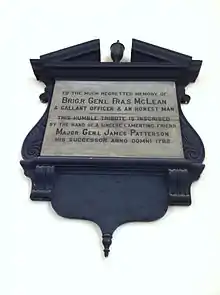 Brigadier General Francis McLean – defended New Ireland (Maine) during American Revolution, died 1781 – oldest monument in church
Brigadier General Francis McLean – defended New Ireland (Maine) during American Revolution, died 1781 – oldest monument in church
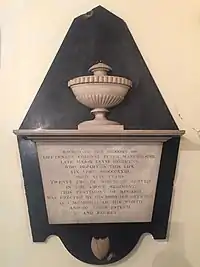 Lt.-Col. Peter Waterhouse by Lancelot Edward Wood (Chelsea, London), fought in the Battle of Corunna
Lt.-Col. Peter Waterhouse by Lancelot Edward Wood (Chelsea, London), fought in the Battle of Corunna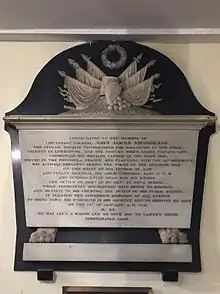 Lt.-Col. John James Snodgrass, fought in Battle of Waterloo (1815)
Lt.-Col. John James Snodgrass, fought in Battle of Waterloo (1815)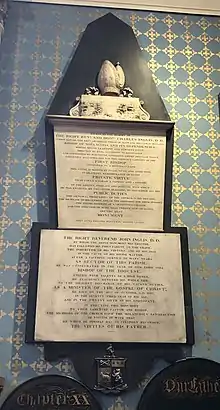 First Anglican Bishop in North America Charles Inglis
First Anglican Bishop in North America Charles Inglis
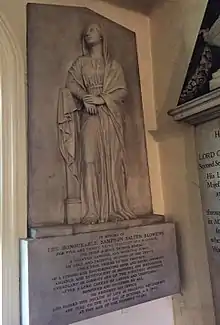 Chief Justice Sampson Salter Blowers, died 1842 – loyalist, instrumental in ending slavery in Nova Scotia
Chief Justice Sampson Salter Blowers, died 1842 – loyalist, instrumental in ending slavery in Nova Scotia
 Father of Confederation Hon. John William Ritchie, died 1890
Father of Confederation Hon. John William Ritchie, died 1890 Lt. Gov. Sir John Harvey, fought in Battle of Crysler's Farm
Lt. Gov. Sir John Harvey, fought in Battle of Crysler's Farm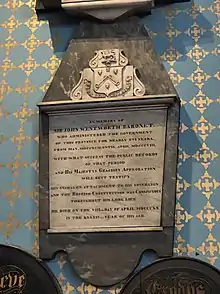 Lt. Gov. John Wentworth, Col of Royal Nova Scotia Regiment
Lt. Gov. John Wentworth, Col of Royal Nova Scotia Regiment
Women
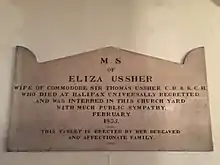 Captain Sir Thomas Ussher's wife Eliza Ussher, died 1835 (large tomb in St. Paul's cemetery)[8]
Captain Sir Thomas Ussher's wife Eliza Ussher, died 1835 (large tomb in St. Paul's cemetery)[8]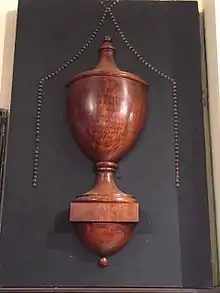 Commander-in-Chief, North American Station Rear Admiral Herbert Sawyer's daughter Sophia Sawyer, died 1788
Commander-in-Chief, North American Station Rear Admiral Herbert Sawyer's daughter Sophia Sawyer, died 1788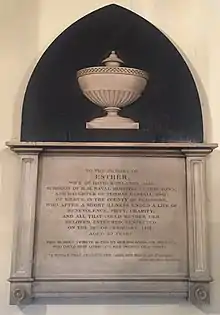 Dr. David Rowlands' wife Esther Rowlands (gravestone in St. Paul's cemetery)
Dr. David Rowlands' wife Esther Rowlands (gravestone in St. Paul's cemetery)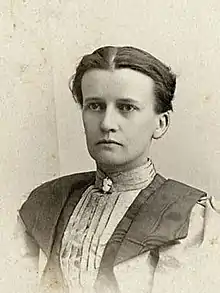 Suffragist Eliza Ritchie (d.1933) and Sisters windows
Suffragist Eliza Ritchie (d.1933) and Sisters windows Philanthropist and Business woman Isabella Binney Cogswell, died1874
Philanthropist and Business woman Isabella Binney Cogswell, died1874
Silver communion service

The service originally consisted of five pieces: four pieces have the mark of King Georges I (2 flagons, a Chalice and an alms receiver[10]). Two of these pieces also have the mark of Queen Anne (a flagon and the alms receiver), which are dated 1713. The fifth piece – the paten – was damaged and melted down around 1819.[11] All the pieces are made from Britannia silver. In 1783, Governor Parr had the service given to St. Paul's.[12][13]
The silversmith Francis Garthorne (1641–1729) marked all of the pieces with a "G" that surrounded a small Roman capital A. Garthorne's work is in the collections of Metropolitan Museum of Art (New York), Museum of Fine Arts (Boston) and the Royal Collection Trust. He created five of the ten Ceremonial maces in the United Kingdom on display in the Jewel House at the Tower of London.
Sculptures
Some of the monuments in the church showcase sculptures by England's leading sculptors during the nineteenth century. All of whom exhibited their work at the Royal Academy of Arts and have their work in the National Portrait Gallery (London), the Tate, Museum of Fine Arts (Boston), Massachusetts State House, Trafalgar Square, St Pauls Cathedral, Buckingham Palace and Westminster Abbey.
There are two stone carvings by Samuel Nixon, one of a shipwreck and the other of the Parable of the Good Samaritan. Nixon was commissioned by the City of London to create a statue of King William IV (1844), which Gentleman’s Magazine called "a masterpiece" and an example of "artistic genius."[14]
Another sculpture was created by Sir Francis Leggatt Chantrey (for Amelia Ann Smyth). Chantrey's most notable works include the statues of King George IV (Trafalgar Square); King George III (Guildhall), and George Washington (Massachusetts State House). He also executed four monuments to military heroes for St Pauls Cathedral. (Chantrey's sculpture of Sir Walter Scott was commissioned for Victoria Park, Halifax, Nova Scotia.)
There is also a sculpture by Richard Westmacott III (for Sampson Salter Blowers).[15][16] Westmacoott was the son of Sir Richard Westmacott. Among Westmacott III's most notable works is the pediment of the Royal Exchange (London); the monument commemorating Sir John Franklin (Greenwich Hospital). (Westmacott's uncle architect John Westmacott (d. 1816) is buried in the Old Burying Ground in Halifax, Nova Scotia.)
There is a sculpture in St. Paul's Church by John Gibson (for Richard John Uniacke, Jr.) and a monument by William F. Woodington (Henry Hezekiah Cogswell's monument to his children). Woodington's work includes statues on Westminster Bridge, Nelson’s Column (Trafalgar Square), St. Paul’s Cathedral, and the House of Lords.
.png.webp) Richard Westmacott III (1799–1872)
Richard Westmacott III (1799–1872)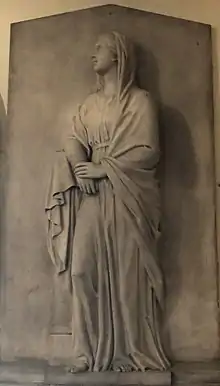 Monument by Richard Westmacott III (for Sampson Salter Blowers, 1842)
Monument by Richard Westmacott III (for Sampson Salter Blowers, 1842)
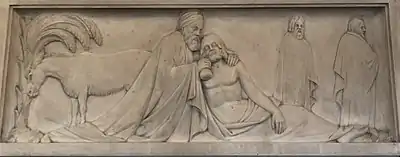
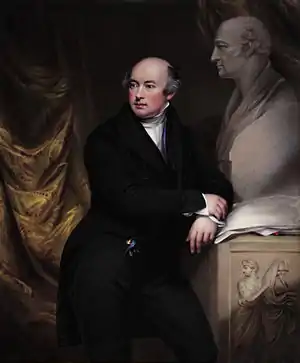
 Monument by Sir Francis Leggatt Chantrey (for George Stracey Smyth's wife, 1817)
Monument by Sir Francis Leggatt Chantrey (for George Stracey Smyth's wife, 1817).jpg.webp)
_2.jpg.webp)
.png.webp) William F. Woodington (1806–1893)
William F. Woodington (1806–1893) William F. Woodington (for Henry Hezekiah Cogswell's monument to his children, 1839)
William F. Woodington (for Henry Hezekiah Cogswell's monument to his children, 1839)
Ministers (1749–1824)
- Rev. William Tutty (1749–1752) and his assistant, Rev. William Anwyl (1749–1750),
- Rev. Jean-Baptiste Moreau (clergyman) (1750–1753) took on the role of Tutty's assistant; later became the 1st minister of St. John's Anglican Church (Lunenburg)[17]
- Rev. Thomas Wood (1752–1764) (assistant); 1st minister at Annapolis; buried at Garrison Cemetery (Annapolis Royal, Nova Scotia)
- Rev. John Breynton (1753–1791), first Rector[18]
- Charles Inglis, 1st Bishop of Nova Scotia, (1781), only minister buried in crypt
- Rev. Joshua Wingate Weeks (1785–1791), brother-in-law of Rev. Jacob Bailey[19][20][21][22][23][24]
- Rev. Robert Stanser (1791–1816), 2nd Bishop – his wife Mary Stanser, died 1815, is buried in the crypt
- Rev. John Inglis (1816–1824), 3rd Bishop (appointed 1825, father of John Eardley Inglis).
- Rev. John Thomas Twining (curate) (1817)
- Rev. William Cogswell (minister) (Henry Hezekiah Cogswell's son) (curate), (1833–1847)[25][26]
- Rev. Robert Willis (minister) (1824–1865)[27]
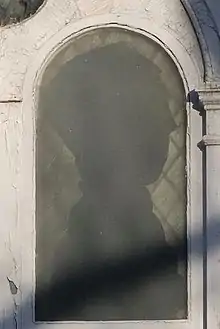
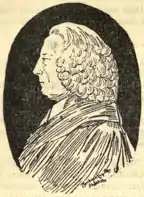 Reverend Thomas Wood (1752–1764)[28]
Reverend Thomas Wood (1752–1764)[28]
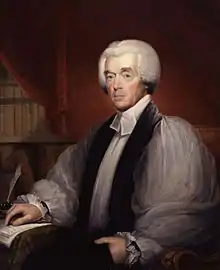 Charles Inglis. died 1816, 1st bishop
Charles Inglis. died 1816, 1st bishop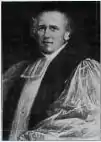 Rev. Robert Stanser, 2nd Bishop
Rev. Robert Stanser, 2nd Bishop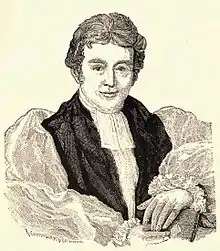 Rev. John Inglis, 3rd Bishop
Rev. John Inglis, 3rd Bishop Rev. William Cogswell, St. Paul's Church, Halifax, Nova Scotia
Rev. William Cogswell, St. Paul's Church, Halifax, Nova Scotia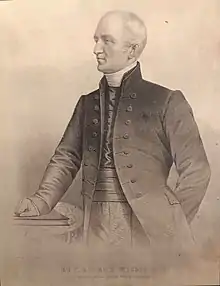 Rev. Robert Willis, St. Paul's Church, Halifax, Nova Scotia
Rev. Robert Willis, St. Paul's Church, Halifax, Nova Scotia
The crypt and commemorations
The crypt contains the remains of 20 congregants which are listed below.[29] Also indicated below are those that have been commemorated in the church through a plaque, a hatchment or a window.
Founders of Halifax
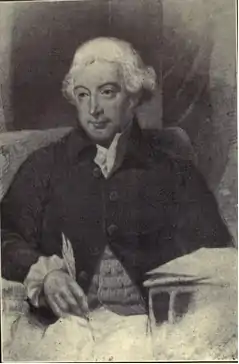 Charles Lawrence. died 1760, Governor of Nova Scotia, 1st person buried in the crypt; participated in the Battle at Chignecto and Siege of Louisbourg (1758)
Charles Lawrence. died 1760, Governor of Nova Scotia, 1st person buried in the crypt; participated in the Battle at Chignecto and Siege of Louisbourg (1758)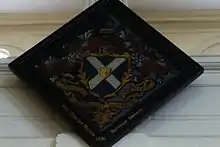 Charles Morris, died 1781 – Battle of Grand Pré; 2nd Chief Justice (1776–1778) (hatchment)
Charles Morris, died 1781 – Battle of Grand Pré; 2nd Chief Justice (1776–1778) (hatchment)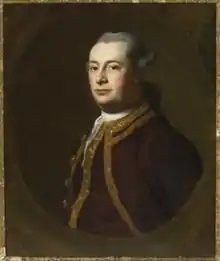 Michael Francklin, died 1782
Michael Francklin, died 1782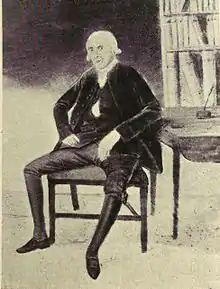 Richard Bulkeley, died 1800[30]
Richard Bulkeley, died 1800[30]
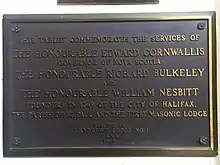

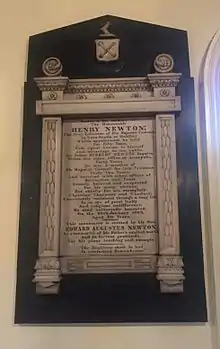 Henry Newton, died 1802
Henry Newton, died 1802
American Revolution
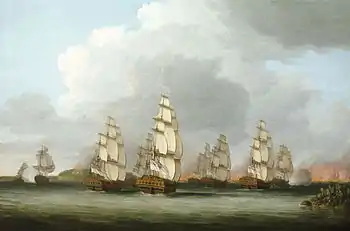 Francis McLean – led land forces to protect New Ireland (Maine) during American Revolution, died 1781 – oldest stone memorial in church
Francis McLean – led land forces to protect New Ireland (Maine) during American Revolution, died 1781 – oldest stone memorial in church
 Lord Charles Montagu, (Loyalist) Governor of South Carolina (1766–1773)
Lord Charles Montagu, (Loyalist) Governor of South Carolina (1766–1773)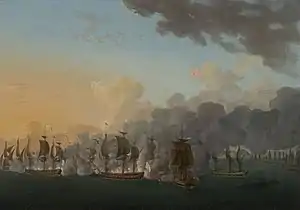 Capt Henry Francis Evans - led the naval forces to protect New Ireland; killed in the Naval Battle off Cape Breton (1781)(plaque)
Capt Henry Francis Evans - led the naval forces to protect New Ireland; killed in the Naval Battle off Cape Breton (1781)(plaque)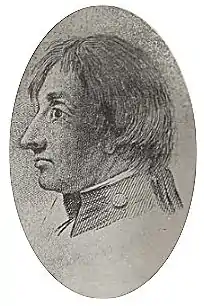
 Chief Justice Bryan Finucane, died 1785, 3rd chief justice (1778–1785)[34]
Chief Justice Bryan Finucane, died 1785, 3rd chief justice (1778–1785)[34]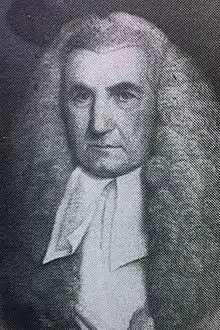 Chief Justice Sampson Salter Blowers, died 1842 – loyalist, instrumental in ending slavery in Nova Scotia (memorial template)
Chief Justice Sampson Salter Blowers, died 1842 – loyalist, instrumental in ending slavery in Nova Scotia (memorial template)
- Lieutenant General William Neville Gardiner, died 1806, (crypt, no plaque) fought alongside Sir William Howe in the Philadelphia campaign (1777) and was wounded in the Battle of Monmouth.[35]
French Revolutionary Wars (1792–1802)
 John Wentworth, died 1820, Governor of Nova Scotia (1792–1808)
John Wentworth, died 1820, Governor of Nova Scotia (1792–1808)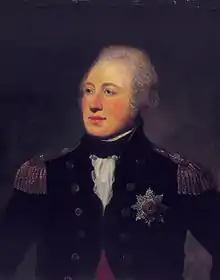 Vice-Admiral Andrew Mitchell, Commander-in-Chief, North American Station (1802–1806) wife, Lady Mary Mitchell, died 1825 – daughter of Richard John Uniacke
Vice-Admiral Andrew Mitchell, Commander-in-Chief, North American Station (1802–1806) wife, Lady Mary Mitchell, died 1825 – daughter of Richard John Uniacke
- Lieutenant Colonel David Meredith, died 1809
Napoleonic Wars (1803–1815)
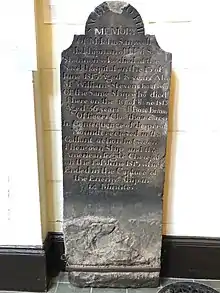 Gravestone for two crew members, HMS Shannon, 1813
Gravestone for two crew members, HMS Shannon, 1813.png.webp) Captain Sir Thomas Ussher's wife Eliza Ussher, died 1835 (plaque)[8]
Captain Sir Thomas Ussher's wife Eliza Ussher, died 1835 (plaque)[8]_by_Robert_Field.jpg.webp) Herbert Sawyer's sister Sophia Sawyer, died 1788 (crypt, plaque) – Daughter of Rear Admiral Herbert Sawyer, Commander-in-Chief, North American Station (1785–1789)
Herbert Sawyer's sister Sophia Sawyer, died 1788 (crypt, plaque) – Daughter of Rear Admiral Herbert Sawyer, Commander-in-Chief, North American Station (1785–1789) Dr. David Rowlands' wife Esther Rowlands Monument
Dr. David Rowlands' wife Esther Rowlands Monument
- Lt. Col. Peter Waterhouse (military officer), c. 1823 81st Regiment of Foot (plaque; tomb in Old Burying Ground)
- Lieutenant-Colonel John James Snodgrass (1796–1841), a British military officer, fought in the Battle of Waterloo (1815) and was an aide-de-camp to Sir Archibald Campbell, 1st Baronet and author. (plaque; tomb in Old Burying Ground)
- John George Deware (Dewar), HMS Rose, died 1830 (plaque; also gravestone in St. Paul's cemetery)[36]
Second Boer War
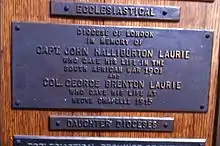
- Stanley Banfield, d. , 2nd Canadian Mounted Rifles (plaque)
- Capt. John Halliburton Laurie, died 1901, son of John Wimburn Laurie (plaque)
WW1
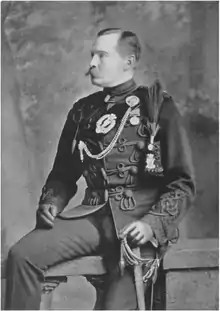 George Brenton Laurie, died 1915, son of John Wimburn Laurie, (plaque)
George Brenton Laurie, died 1915, son of John Wimburn Laurie, (plaque)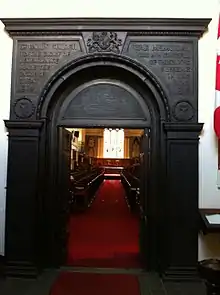 WW1 Doorway Arch - engraved with names of Nova Scotians who died (also commemorating William James Armitage who gathered the names of the war dead)[37]
WW1 Doorway Arch - engraved with names of Nova Scotians who died (also commemorating William James Armitage who gathered the names of the war dead)[37]
Other
- Lt. Gov. of Nova Scotia Peregrine Maitland's infant son George Bertie Maitland, (crypt) died 1831
- Rear admiral Leonard W. Murray, died 1971 – ashes in the Naval Columbarium (Naval Vault)
- Alfred Gilpin Jones
- Charles Francis Norton, died 1835, 52nd Light Infantry (monument)
- Capt. Douglas, HMS Sylph, died 1813[38]
- Sarah Mudge, died 1818 (crypt)[39]
- Captain John Oakes Hardy (Okes)'s, of HMS Assistance, wife Susan (Woodcock) Hardy, daughter of Dr. Edward Woodcock rector at Watford (member of Society for Promoting Christian Knowledge);[40][41][42][43] married at Edmonton, Middlesex, England, m. 1794, died 1799; Hardy commanding HMS St. Albans was part of the capture of l'Elizabeth French frigate, under Vice-Admiral George Murray, Aug, 28, 1796; Hardy commanding HMS Courageux for reduction of St. Lucia, 22 June 1803.[44][45][46][47][48][49][50][51][52][53]
- Joseph Frederick Wallet DesBarres – Governor of Prince Edward Island and Cape Breton is buried at St. George's Church
- Window for Jane Tremaine, Sunday school Teacher for 65 years; only memorial Window destroyed in the explosion[54]
Prominent families
Uniacke Family
The family of Richard John Uniacke dominates the plaques and monuments in St. Paul's Church. (On separate occasions, two Uniacke family members stood trial for murder.)
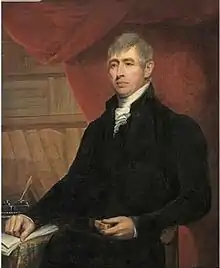
 Martha Uniacke
Martha Uniacke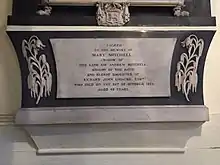 Mary (Uniacke) Mitchell (wife of Andrew Mitchell)
Mary (Uniacke) Mitchell (wife of Andrew Mitchell)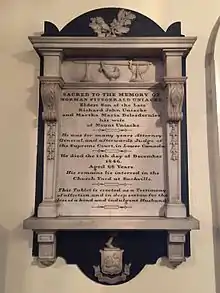
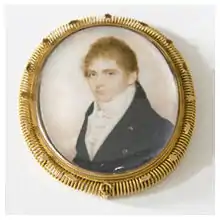
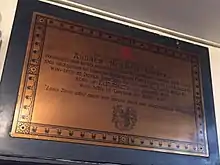
 Robie Uniacke window, died 1904
Robie Uniacke window, died 1904
Almon Family
The memorials to the family of Dr. William James Almon also dominant the church. There were four generations of doctors in the family that had a significant impact on the field of medicine in the province.
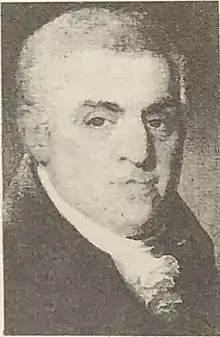 William James Almon, died 1817
William James Almon, died 1817 Rebecca Byles Almon, died 1852, (plaque) wife of William James Almon; oldest child of Mather Byles[55][56]
Rebecca Byles Almon, died 1852, (plaque) wife of William James Almon; oldest child of Mather Byles[55][56]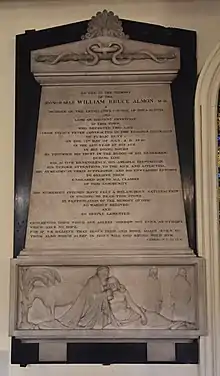 William Bruce Almon, died 1840
William Bruce Almon, died 1840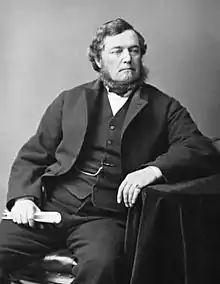 William Johnston Almon, died 1901
William Johnston Almon, died 1901
- Amelia Rebecca (Almon) Ritchie – daughter of William Bruce Almon – memorial plaque
- John Egan Almon, died 1917 (plaque)
- William Bruce Almon (1875–1940) (plaque)
Cogswell Family
The memorials to the family of Henry Hezekiah Cogswell also dominant the church. There are monuments placed to four of his children, three of which died while Henry was alive. His son Rev. William became a celebrated orator and author.
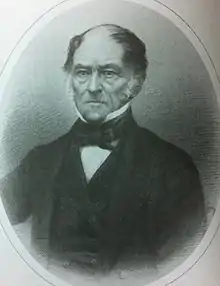
 Henry H. Cogswell children's monument by William F. Woodington
Henry H. Cogswell children's monument by William F. Woodington Cogswell monument to his daughter Isabella Binney Cogswell
Cogswell monument to his daughter Isabella Binney Cogswell Rev. William Cogswell[57]
Rev. William Cogswell[57] Rev. William Cogswell Monument
Rev. William Cogswell Monument
Ritchie Family
The memorials to the family of Hon. John William Ritchie also dominant the church. There are memorial windows placed for a son and five of his daughters. His twelve children donated money for the memorial window on the south side of the church.
 Hon. John William Ritchie, died 1890 – Father of Confederation
Hon. John William Ritchie, died 1890 – Father of Confederation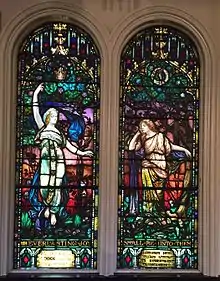 Suffragist Eliza Ritchie (d.1933) and Sisters window
Suffragist Eliza Ritchie (d.1933) and Sisters window Ella Almon Ritchie
Ella Almon Ritchie Joseph Norman Ritchie
Joseph Norman Ritchie Thomas Ritchie
Thomas Ritchie
Notable events
Marriages
 Horatio Gates is married to Elizabeth Phillips on October 20, 1754[58]
Horatio Gates is married to Elizabeth Phillips on October 20, 1754[58]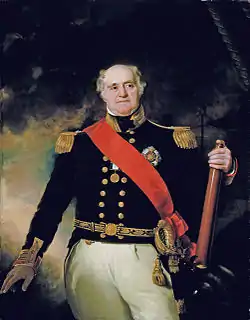 Sir Thomas Masterman Hardy, married daughter of Sir George Cranfield Berkeley, 17 November 1807
Sir Thomas Masterman Hardy, married daughter of Sir George Cranfield Berkeley, 17 November 1807
Funerals
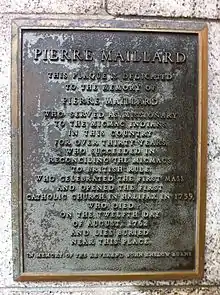 Catholic Priest Pierre Maillard funeral is attended by large number of Mi'kmaq (1762)[59]
Catholic Priest Pierre Maillard funeral is attended by large number of Mi'kmaq (1762)[59] NS Governor Michael Francklin funeral is attended by a large number of Mi'kmaq (1782)
NS Governor Michael Francklin funeral is attended by a large number of Mi'kmaq (1782)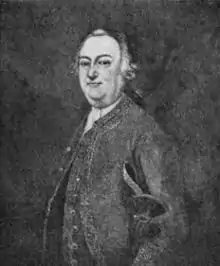
 Funeral for Richard Bulkeley, died 1800, was "the largest ever seen in Halifax."[65]
Funeral for Richard Bulkeley, died 1800, was "the largest ever seen in Halifax."[65] Captain James Lawrence, USS Chesapeake (1813)
Captain James Lawrence, USS Chesapeake (1813)
Royal visits
- Saint Paul's has a royal pew, and many royal guests have visited, including the father of Queen Victoria, Prince Edward, and Princesses Michael (1984), Margaret, Alexandra, and Elizabeth (Queen Elizabeth II), and Prince Edward in 1987. However, HRH Prince George, later to become King George V of the United Kingdom, declined to use the royal pew during his visits to Halifax as the commander of HMS Thrush (1891).[66]
 Prince William Henry - later King William IV attended (1786)
Prince William Henry - later King William IV attended (1786) Prince Edward attended (1794)
Prince Edward attended (1794) Prince Edward, later King Edward VII attended (1860)
Prince Edward, later King Edward VII attended (1860)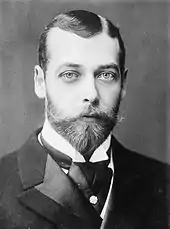 George V (1891)
George V (1891)
Halifax Explosion

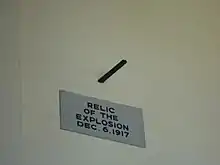
St. Paul's Church played a significant role in the Halifax Explosion. Doctors used the church as an emergency hospital, using the two vestries to tend to the wounded, while the bodies of the dead were stacked on top of each other around the walls of the nave.[67][68] Only one stained glass window was broken in the church; however, most of the other windows were smashed, and there were wide cracks in the roof. It was the only church in the city considered safe enough to conduct a service the following day. All the congregations used the church to conduct funerals.
There remains two artifacts in the church from this disaster: the "Explosion Window", which shattered to form a silhouette of a man's head and shoulders. The congregation concluded that the silhouette is the likeness of Abbe Moreau, who arrived with Cornwallis. There is also a piece of a steel window frame that remains embedded in the wall of the vestibule above the inside doors to the church.
See also
- Little Dutch (Deutsch) Church
- St. Matthew's United Church (Halifax)
- St. John's Anglican Church (Lunenburg)
- List of oldest buildings and structures in Halifax, Nova Scotia
- History of the Halifax Regional Municipality
- History of Nova Scotia
- Military history of Nova Scotia
- List of oldest buildings in Canada
References
Texts
- J. Philip McAleer. A pictorial history of St. Paul's Anglican Church, Halifax, Nova Scotia 1 edition Appendix 2, 1993
- Thomas, C. E. (1974). "Tutty, William". In Halpenny, Francess G (ed.). Dictionary of Canadian Biography. III (1741–1770) (online ed.). University of Toronto Press.
- Memorials at St. Paul's Church, Acadiensis, p. 58
- History of St. Paul's Church. PART 1. Collections of the Nova Scotia Historical Society
- History of St. Paul's Church. PART 2. Collections of the Nova Scotia Historical Society
- C.E. Thomas. St. Paul's Church, Halifax, Revisited. Collections of the Nova Scotia Historical Society. 1961. Vol. 33, pp. 26–27.
- Harris, V, The Church of St Paul, Halifax, Nova Scotia 1749–1949 (Toronto: 1949)
- The Chancel of St. Paul's Anglican Church, Halifax, Nova Scotia: Form Follows Convenience by J. PHILIP McALEER RACAR: revue d'art canadienne / Canadian Art Review, Vol. 17, No. 1 (1990), pp. 46-53, 99-101
Endnotes
- St. Paul's Anglican Church. Canadian Register of Historic Places. Retrieved 16 April 2013.
- It was the second protestant church ever established in Canada. The first was Cathedral of St. John the Baptist (St. John's), Newfoundland (1699).
- St. Paul's Anglican Church National Historic Site of Canada. Canadian Register of Historic Places. Retrieved 16 April 2013.
- St. Paul's Anglican Church National Historic Site of Canada. Directory of Federal Heritage Designations. Parks Canada.
- Pound, Richard W. (2005). 'Fitzhenry and Whiteside Book of Canadian Facts and Dates'. Fitzhenry and Whiteside.
- Breynton was absent from 1785–1791.
- Baxter Emsley, Sarah (1999). St. Paul's in the Grand Parade. halifax: Formac Publishing Company Ltd. p. 4. ISBN 0-88780-487-X.
- https://archive.org/stream/acadiensisquarte05jackuoft#page/98/mode/1up/search/ussher
- Charles Vernon. Early Days of the Church in Nova Scotia. 1910.
- https://www.episcopalchurch.org/library/glossary/alms-basin
- http://www.stpaulshalifax.org/wp-content/uploads/2014/03/2014-Lent-St-Pauls-Journal-RRR.pdf
- Tinker McKay. Francis Garthorne. Lent 2014. St. Paul's Journal, pp. 5-6
- "Chapel Plate for Nova Scotia" by Lauretta Harris and Tinker McKay is in the British magazine "Silver Studies" #28 published in 2012.
- Samuel Nixon. Obituary. Gentleman’s Magazine. Vol. 42, p. 406
- A Biographical Dictionary of Sculptors in Britain, 1660-1851
- Harris, V, The Church of St Paul, Halifax, Nova Scotia 1749-1949 (Toronto: 1949)
- p. 81
- http://www.biographi.ca/en/bio/breynton_john_4E.html
- Find a grave with bio
- A sermon
- Loyalist from Salem
- Collections of the Society, Volume 2. Protestant Episcopal Historical Society. 1853. p. 315. Retrieved 19 July 2019.
rev. wingate weeks. St. Michael's church, marblehead, mass.
- https://archive.org/stream/collectionsofnov02nova#page/69/mode/1up
- The Church of England in Nova Scotia and the Tory Clergy of the Revolution By Arthur Wentworth Hamilton Eaton, p. 184
- "A sermon, preached in St. Paul's Church, Halifax: on the occasion of the death of the Revd. William Cogswell, A.M., curate of said parish, on Sunday, 13th June, 1847" / by Robert Willis.
- https://archive.org/details/cihm_22739/page/n49
- http://www.biographi.ca/en/bio/willis_robert_9E.html
- Thomas, C. E. (1979). "Wood, Thomas". In Halpenny, Francess G (ed.). Dictionary of Canadian Biography. IV (1771–1800) (online ed.). University of Toronto Press.
- For the list see J. Philip McAleer. A pictorial history of St. Paul's Anglican Church, Halifax, Nova Scotia 1 edition Appendix 2, 1993. pp.142–143
- While a display inside the church states that Buckeley is buried in the crypt, according to J. Philip McAleer, the evidence that Bulkeley was buried in the church is circumstantial. This circumstantial evidence rests on the fact that he helped establish the church and was an active member in it for 51 years. Also Buckeley is reported to have had the largest funeral ceremony ever to be in Halifax up to that date. Further, his wife Mary Rous has a headstone in the St Paul's Church Cemetery, while Buckeley does not. Rev Hill, however reports that Bulkeley's grave is marked by a rude stone in St. Paul's Church cemetery, presumably close to the gravestone of his wife Mary Rous. (See Collections of the Nova Scotia Historical Society, Vol. 2, p. 69)
- p. 289
- Colonel of the Hesse Cassel Garrison Regiment Von Seitz - see Hessian (soldiers). The Baron fought in the American Revolution, particularly on 16 November 1776, he captured Fort Washington; 1776–1778, Garrisoned New York; 1778–1783, Garrisoned Halifax. See "The Hessians of Nova Scotia" by John H Merz and Winthrop P. Bell entitled, "A Hessian conscript's account of life in garrison at Halifax at the time of the American Revolution". Collections of the Nova Scotia Historical Society, Volume 27, 1947
- https://archive.org/stream/collectionsofnov01novauoft#page/n59/mode/1up
- Barry Cahill, “The Career of Chief Justice Bryan Finucane,” Nova Scotia Historical Society Collections, vol. 42 (1986), pp. 153-69.
- Harris, V, The Church of St Paul, Halifax, Nova Scotia 1749-1949 (Toronto: 1949), p. 288, 291
- A Sort of Conscience: The Wakefields By Philip Temple
- http://www.stpaulshalifax.org/wp-content/uploads/2015/10/Great-War-Panels-website.compressed_11.pdf
- 5 Mar 1813, Halifax, arrived the Sylph, Capt. Douglas, from Bermuda, having lost her boats and anchors in bad weather after parting from the Childers, and reports the Britannia, with whom she separated on 20 Feb., now arrived Halifax 11 Mar.
- Captain John Mudge b. 1792 d. 1872 m. Sarah Jessie Henrietta Colton b. 1796 d. 1818. Dolphin, about October 1777, captured the 100-ton brigantine Salisbury (John Mudge). Dolphin was sent into Massachusetts, where she was libeled in the Massachusetts Court of the Middle District on 6 November 1777, with trial set for 27 November.46
- Could also be wife of Captain Thomas Hardy of HMS Quirrel and HMS Greyhound (St. Paul's History, 1949, p. 295
- Will of Reverend, Doctor Edward Woodcock, Doctor of Laws, Vicar of Watford, Rector of the United Parishes of Saint Michael Wood Street and Saint Mary Steyning in the City of London of Watford , Hertfordshire
- p. 45
- p.117
- [Capt. John Okes Hardy halifax saint albans p.1075]
- https://threedecks.org/index.php?display_type=show_crewman&id=8016
- https://archive.org/details/calendarofwillso01fern/page/204
- p.146
- https://archive.org/details/navalchronicleco17lond/page/300
- p.212
- p.145
- Susan Woodcock, p. 399
- marriage to Susan Woodcock, p.404
- p.383
- https://memoryns.ca/st-pauls-church-halifax-sunday-school
- Rebecca “Becca” Byles Almon Find A Grave
- Canadian Biography
- [• http://onlinebooks.library.upenn.edu/webbin/book/lookupname?key=Cogswell%2C%20William%2C%201810-1847 Online Books by William Cogswell]
- p. 343
- Collections of the Nova Scotia Historical Society. Vol. 1, p. 44
- father of Edward Winslow (loyalist), his former home now belongs to the Mayflower House Museum
- Winslow's tombstone is inscribed in part "his fortune suffered shipwreck in the storm of civil war", the "civil war" being the American Revolution, American Patriots fighting American Loyalists.
- p. 786
- https://archive.org/stream/winslowmemorialf0001holt#page/58/mode/2up/search/nova+scotia
- https://archive.org/stream/collectionsmass35socigoog#page/n190/mode/2up/search/edward
- https://archive.org/stream/collectionsofnov12nova#page/n111/mode/2up
- Baxter Emsley, Sarah (1999). St. Paul's in the Grand Parade. Halifax: Formac Publishing Company Ltd. pp. 47–48. ISBN 0-88780-487-X.
- C.E. Thomas. St. Paul's Church, Halifax, Revisited. Collections of the Nova Scotia Historical Society. 1961. Vol. 33, pp. 26-27.
- http://www.stpaulshalifax.org/wp-content/uploads/2017/12/St.-Pauls-and-the-Great-War-The-Halifax-Explosion.pdf
External links
| Wikimedia Commons has media related to St. Paul's Anglican Church (Halifax). |